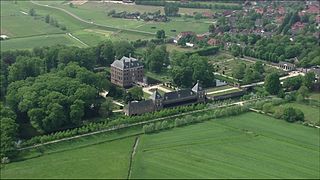Amerongen Castle
Amerongen Castle ( Dutch Kasteel Amerongen ) is a moated castle in the Amerongen district of the municipality of Utrechtse Heuvelrug, which was originally built in 1286 . The current palace complex was built after 1672 and is one of the hundred most important Rijksmonumenten in the Netherlands . Amerongen Castle was the place of the personal abdication of Kaiser Wilhelm II on November 28, 1918 and first residence in Dutch exile from 1918 until the move to the neighboring Doorn house in 1920.
history
The village of Amerongen was first mentioned in 1126. The construction of a castle in Amerongen was documented for the first time on July 20, 1286 in a loan document from Count Florens V of Holland for the brothers Borre and Diederic van Amerongen. The castle remained the seat of the Borre family until the middle of the 15th century and after a few changing owners it came to Goert van Reede van Saesveld (1516–1585) in 1557. He came from an old Westphalian aristocratic family who had married into the Overijssel area and settled there. The Reedes remained the owners of Amerongen until the second half of the 19th century. Goert van Reede's tomb with the life-size sculptures of Goerts and his wife Gertrud, made by the Renaissance sculptor Jacob Colijn de Nole , is located in the church of Amerongen, where the coats of arms of the van Reede family are also hung as epitaphs . Amerongen was fought over shortly before Goert van Reede's death in the Eighty Years' War in 1583 and briefly conquered by the Spaniards. Due to his leadership role in the declaration of independence of the seven provinces ( Union of Utrecht ), his image can also be found on the Reformation monument in Geneva .
The great-grandson Godard Adriaan van Reede (1621–1691) was formative for Amerongen Castle. He inherited the house and the associated farm in 1641. The house, which largely dates back to the Middle Ages, was devastated and burned down in 1672 by the troops of King Louis XIV of France. Godard Adriaan van Reede and his wife Margaretha Turnor (1613–1700) rebuilt it as a baroque moated castle made of brick with seven axes and a central projection , as it essentially appears today. Among other things, a brick factory had to be built for this purpose. The only son of the two was named Herr van Ginckel and was known under this name as the general of the cavalry, which was successfully deployed against the Irish for the English king. In memory of the Battle of Athlone (1691), Ginckel was made Count of Athlone by the English king.
With the death of the 8th Count of Athlone in 1842, the van Roads died out in the male line. After complicated inheritance disputes, Amerongen Castle fell to Count Godard von Aldenburg Bentinck (1857–1940) in 1878 , whose family had gained prominence through the Bentinck succession dispute over Varel and the Kniphausen rule in 1854. Under him, the castle was thoroughly renovated by the architect Pierre Cuypers .
From 1918 until the completion of the renovations and extensions to Haus Doorn, Kaiser Wilhelm II was the guest of the Bentinck family at Amerongen Castle. Here he wrote his certificate of abdication on November 28, 1918 . The house was heavily guarded and controlled by the Dutch military during this time , because the Allies repeatedly demanded the extradition of the emperor during this time in order to bring him before an international war crimes tribunal. The Dutch government refused to extradite them.
Amerongen Castle has been owned by a foundation since 1977 and can be visited with its extensive collections and the park. The castle itself has been extensively renovated for some time with donations.
Web links
- Official website
- Amerongen Castle as a 3D model in SketchUp's 3D warehouse
- Entry on Amerongen Castle or Castle in the scientific database " EBIDAT " of the European Castle Institute (Dutch and German)
Aerial photography

Amerongen Castle seen from the air (still from video by Rijkswaterstaat )
|

Amerongen Castle and surroundings (still from video by Rijkswaterstaat )
|
Coordinates: 51 ° 59 ′ 43 ″ N , 5 ° 27 ′ 30 ″ E



